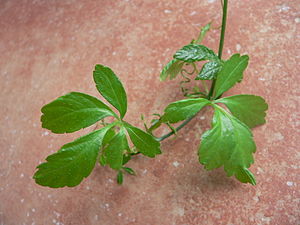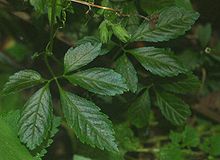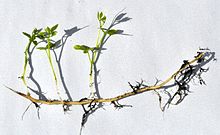Gynostemma pentaphyllum
| Gynostemma pentaphyllum | ||||||||||||
|---|---|---|---|---|---|---|---|---|---|---|---|---|

Gynostemma pentaphyllum |
||||||||||||
| Systematics | ||||||||||||
|
||||||||||||
| Scientific name | ||||||||||||
| Gynostemma pentaphyllum | ||||||||||||
| ( Thunb. ) Makino |
Gynostemma pentaphyllum , German herb of immortality or immortality herb ( Chinese 絞股藍 / 绞股蓝 , Pinyin jiǎogǔlán - "tendril indigo plant", simplified German spelling Jiaogulan ) is a plant species of the pumpkin family (Cucurbitaceae). Parts of the plant are prepared as vegetables, lettuce or tea.
description
Gynostemma pentaphyllum is a slender, climbing, annual to perennial herbaceous plant and reaches growth lengths of four to eight meters. It forms root tubers as a permanent organ. It is finely haired to bald. The tendrils are forked, rarely simple. The membranous to paper-like, nearly symmetrical, unpaired pinnate leaves are simple to foot-shaped composed of five to nine leaflets and range from ovoid to inverted ovoid to lanceolate in shape. The terminal leaflet is 4 to 14 cm long and 2 to 5 cm wide, all other smaller ones. The leaflets are pointed to blunt at the tip, blunt to wedge-shaped at the base and irregularly serrate at the edge, if hairy, then especially along the nerve .
Gynostemma pentaphyllum is dioecious separate sexes ( diocesan ). The inflorescences are up to 30 cm long and drooping. The flowers are small bracts provided, the triangular cup sections 5 to 20 mm long, the yellowish green Kronlappen triangular-lanceolate, and 2 to 3 mm long.
The fruits are round and smooth berries with a diameter of 5 to 8 mm that turn dark green to almost black when ripe.
The number of chromosomes is 2n = 22, 24, 64 or 66.
In China (old Mandarin), Jiaogulan is known as Xiancao,, which means something like 'the herb of immortality' in German.
distribution
Gynostemma pentaphyllum is native to China , Taiwan , Japan , Korea , Thailand , India and the entire Malesian region. It colonizes thickets and thrives at altitudes up to 3200 meters above sea level, but prefers warm and humid climates. It should be able to survive between −15 ° C to +41.5 ° C. The optimal growth temperature, however, is between +15 ° C and +30 ° C. The plant prefers shady growing places with a viable lighting of 40-80% and an optimal lighting of 65-75%. Moist soil rich in nitrogen, phosphorus and humus with a pH value of 5.5 to 8.0 (optimal: 6.5 to 7.0) is ideal for the growth of G. pentaphyllum . The optimal soil is more than 30 cm deep, well ventilated and holds water, e.g. B. sandy loam soils. Under these circumstances the growth and berry production as well as the saponin content (gypenosides) of the plant is highest.
Systematics and botanical history
The plant was first described in 1406 during the Ming dynasty by Zhu Xiao in the book "Medicinal herbs against famine". The first western description was published in 1784 by the Swedish naturalist Carl Peter Thunberg under the name Vitis pentaphylla . The German-Dutch botanist Carl Ludwig Blume transferred it to a different genus as Gynostemma simplicifolium in 1825 . The Japanese botanist Makino Tomitarō kept this decision in 1902, but again used the type epithet of the first description by Thunberg and thus created the taxon Gynostemma pentaphyllum, which is valid today .
ingredients
By 2005, over 100 saponins , called gypenosides or gynosaponins, had been isolated from G. pentaphyllum and identified. The total saponin content is ~ 2.4% of the dried plant. Eight of these gypenosides correspond to the protopanaxadiol-like ginsenosides found in Panax ginseng . These ginsenosides make up around 25% of the total content of gypenosides in the plant and are considered the first evidence of the occurrence of ginseng saponins outside of the aralia family . Studies show that the plant's total saponin content is highest before flowering.
use
In Thailand and China, fresh leaves are used as a salad or similar to spinach. Tea can also be made from both the dried and fresh leaves.
G. pentaphyllum is used in traditional Chinese medicine to evacuate heat, replenish spirit, dissolve poison, lower blood sugar levels, and protect liver function. A common modern indication in China is hyperlipidemia . However, the scientific evidence has so far been limited to animal experiments and small series. For example, Gynostemma pentaphyllum could work against non-alcoholic fatty liver disease. There was no toxic effect in animal experiments on rats. The LD 50 values for the total saponin content are 1.85 g · kg −1 (rat, ip ) and 755–838 mg · kg −1 (mouse, ip). The plant has no medical approval in Europe. It was previously marketed as a dietary supplement ; since the European Union has been demanding approval for novel foods as a so-called "scented herb".
etymology
The scientific name is derived from ancient Greek γυνή gyné , German 'woman' and ancient Greek στέμμα stémma , German 'wreath' as well as from ancient Greek πέντε pénte , German 'five' and ancient Greek φύλλον phýllon , German 'leaf' . It therefore means five-leaf wreath .
literature
- Michael Blumert, Jialiu Liu: Jiaogulan: China's Plant of Immortality . Schulten Frank, 2007, ISBN 978-3-932961-33-5 .
- Valentina Razmovski-Naumovski, Tom Hsun-Wei Huang, Van Hoan Tran, George Qian Li, Colin C. Duke, Basil D. Roufogalis: Chemistry and Pharmacology of Gynostemma pentaphyllum . In: Phytochemistry Reviews . tape 4 , no. 2-3 , July 2005, ISSN 1568-7767 , p. 197-219 , doi : 10.1007 / s11101-005-3754-4 .
- Pui Kei Wu, William CS Tai, Roy CY Choi, Karl WK Tsim, Hua Zhou, Xin Liu, Zhi-Hong Jiang, WL Wendy Hsiao: Chemical and DNA authentication of taste variants of Gynostemma pentaphyllum herbal tea . In: Food Chemistry . tape 128 , 2011, pp. 70-80 , doi : 10.1016 / j.foodchem.2011.02.078 .
- P. Oldenburger, K. David: Jiaogulan, Das kleine Handbuch . Ed .: Kindle. 2nd Edition. No. 2 . Berlin 2017, ISBN 978-1-5497-4686-4 , pp. 44 ( bioherby.de ).
Individual evidence
- ↑ Gynostemma pentaphyllum at Tropicos.org. In: IPCN Chromosome Reports . Missouri Botanical Garden, St. Louis
- ^ P. Oldenburger & David .: Jiaogulan, Das kleine Handbuch. In: Kindle. Bioherby, accessed October 10, 2017 .
- ↑ a b c d e Valentina Razmovski-Naumovski, Tom Hsun-Wei Huang, Van Hoan Tran, George Qian Li, Colin C. Duke, Basil D. Roufogalis: Chemistry and Pharmacology of Gynostemma pentaphyllum. In: Phytochemistry Reviews. 4, 2005, pp. 197-219, doi: 10.1007 / s11101-005-3754-4 .
- ↑ a b W. Y. Guo, WX Wang: Cultivation and utilization of Gynostemma pentaphyllum. Publishing House of Electronics, Science and Technology University, 1993, pp. 1-261.
- ↑ C. Huang, Z. Wu, Y. Yao, X. Xu: Photosynthetic characteristics of Gynostemma pentaphyllum under shade. In: Ying yong sheng tai xue bao = The journal of applied ecology / Zhongguo sheng tai xue xue hui, Zhongguo ke xue yuan Shenyang ying yong sheng tai yan jiu suo zhu ban. Volume 15, Number 11, November 2004, pp. 2099-2103, ISSN 1001-9332 . PMID 15707321 .
- ↑ JG Cheng et al: Investigation of the plant jiaogulan and its analogous herb, Wulianmei . In: Zhong Cao Yao . tape 21 , no. 9 , 1990, pp. 424 .
- ↑ Flora japonica. 105.1784.
- ↑ Bijdr. 23rd 1825.
- ↑ Bot. Mag. (Tokyo). 16, 1902, p. 179.
- ↑ Z. Zhang, SJ Xie, SP Huang, Q. Zhang: Analysis of medicinal and nutritional components in Gynostemma pentaphyllum. In: Shanxi Daxue Xuebao Ziran Kexueban. 16 (3), 1993, pp. 307-310.
- ↑ Xin Liu, Wencai Ye, Ziyao Mo, Biao Yu, Shouxun Zhao, Houming Wu, Chuntao Che, Renwang Jiang, Thomas CW Mak, WL Wendy Hsiao: Five New Ocotillone-Type Saponins from Gynostemma pentaphyllum. In: Journal of Natural Products . 67, 2004, pp. 1147-1151, doi : 10.1021 / np034018 + .
- ↑ S. Ding, Z. Zhu: Resources of genus Gynostemma and determination of their total saponins contents. In: Zhongcaoyao. 23 (12), 1992, pp. 627-629.
- ↑ Zhou, Jiaju, Xie, Guirong, Yan, Xinjian: Encyclopedia of Traditional Chinese Medicines - Molecular Structures, Pharmacological Activities, Natural Sources and Applications. Springer 2011, ISBN 978-3-642-17733-0 .
- ↑ SC Chou, KW Chen et al. a .: The add-on effects of Gynostemma pentaphyllum on nonalcoholic fatty liver disease. In: Alternative therapies in health and medicine. Volume 12, Number 3, 2006 May-Jun, pp. 34-39, PMID 16708768 .
- ↑ Natthakarn Chiranthanut, Supanimit Teekachunhatean, Ampai Panthong, Parirat Khonsung, Duangta Kanjanapothi, Nirush Lertprasertsuk: Toxicity evaluation of standardized extract of Gynostemma pentaphyllum Makino. In: Journal of Ethnopharmacology. 149, 2013, pp. 228-234, doi: 10.1016 / j.jep.2013.06.027 .
- ↑ ÖKO-TEST, May 2013: Readers' questions: Jiaogulantee. ( Memento from August 14, 2014 in the Internet Archive )






